GoPro is resting - in our hands is a new player in the market of action cameras - lympus TG-Tracker. This is a sports camera with a universal set of mounts, a folding display and carefully thought-out ergonomics, ready to shoot video with stabilization with a viewing angle of 204 ° and measure movement data during shooting. Shockproof, waterproof housing, powerful backlight, 4K support and a bunch of nice additions.

What is interesting
Before us is one of the most stuffed with sensors and security systems, a camera that is almost the same in size as its competitors, but at the same time its solid, massive body immediately commands respect. It is felt that the camera was created for demanding professionals, for whom details are important during outdoor activities. In this review, we will explore the Olympus TG-Tracker sports ecosystem and try it out.
Contents of delivery
Like any Olympus photo equipment, the TG-Tracker camera comes in a large box with lots of accessories.
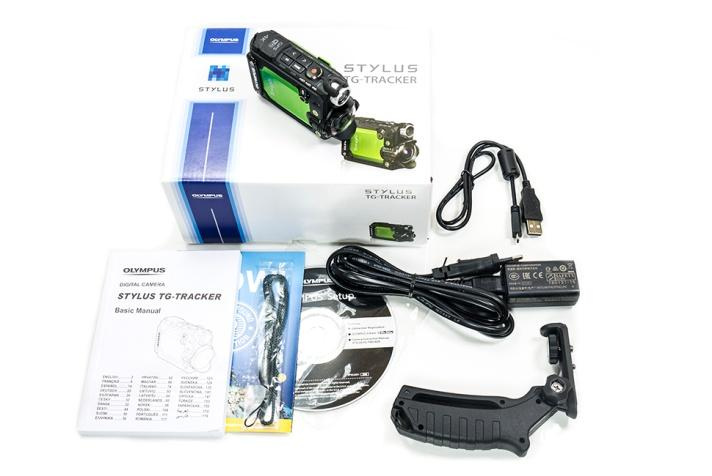
Among them - a network memory unit, micro-USB cable, a handle for manual shooting with cuts under the straps and a chest belt, inch fasteners with a transition system for any fasteners, a wrist strap and a thick instruction. There is an archaic CD with software for OSX and Windows in the box.
Appearance
When you first look at the TG-Tracker, you can immediately notice the family traits of the protected Olympus cameras. This is a rectangular case with optical elements on the right side, a bright front panel, decorated with the characteristics of optics, and many rough protrusions. The case itself is made of durable, rough plastic, which is more common in industrial equipment, “diluted” with a loose screw fasteners.
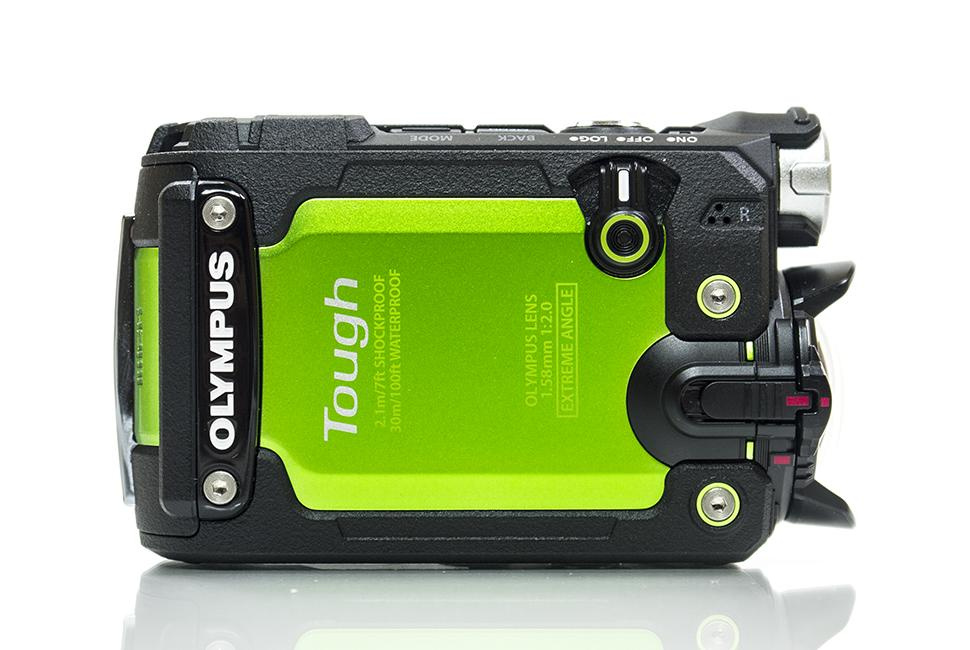
Let's start with optical elements. A massive lens with an extremely wide viewing angle of 204 ° (as a person’s sight) is carefully wrapped in an elastic seal, around which is a retainer for protective hoods.
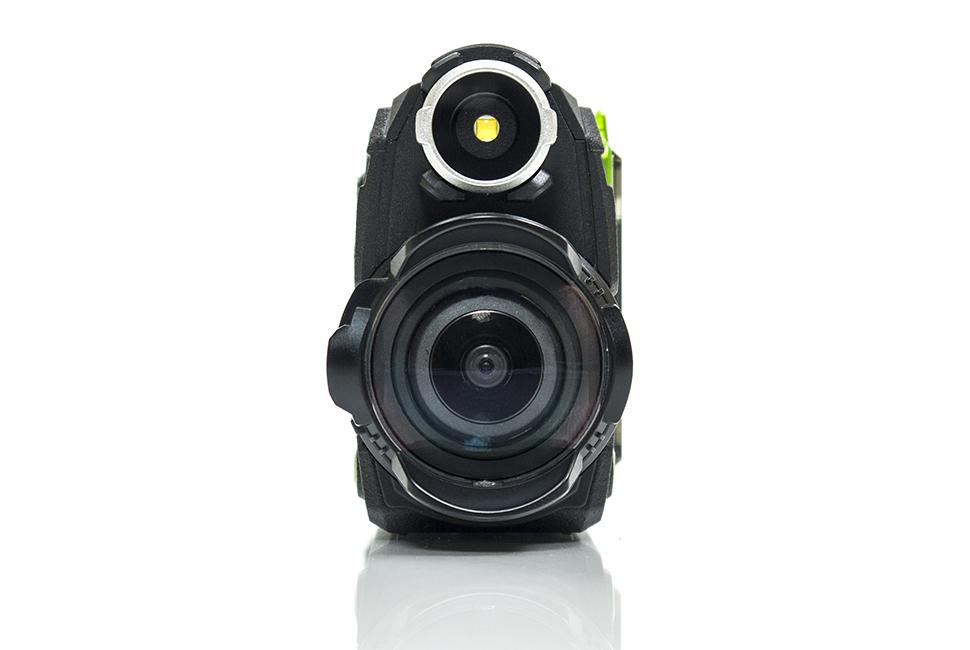
The set includes two anti-glare glass: convex and flat rectangular. The first is suitable for a wet environment, and the second is easier to brush away the dust and dirt, which is useful when shooting racing races on the road.
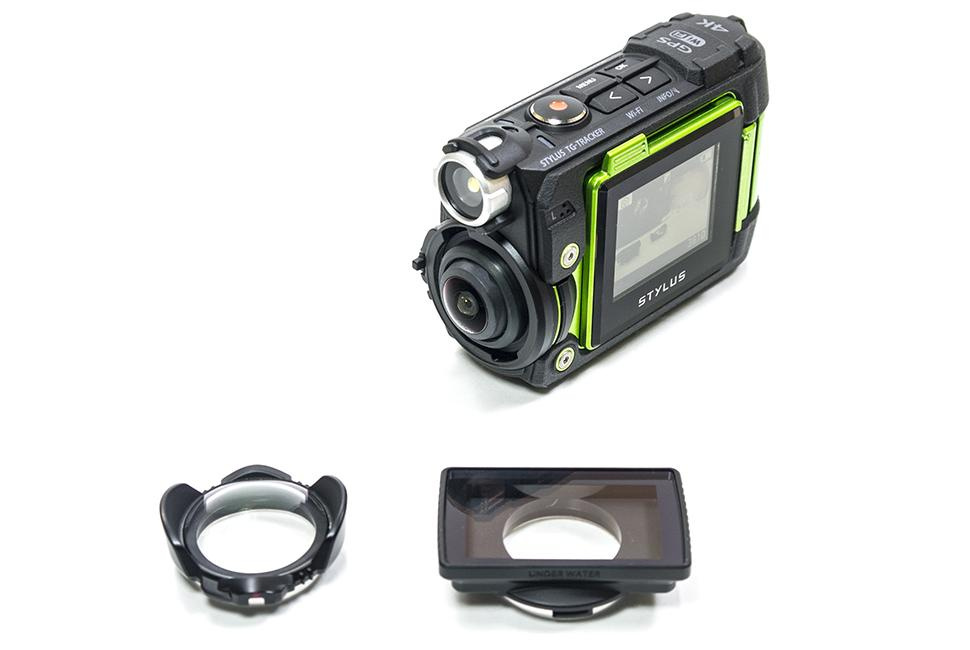
The hood is fixed with a spring latch, and the installation and removal process resembles the replacement of a DSLR lens.
Above the lens is a powerful LED backlight, which is activated for one minute by holding the ">" key, or it turns on when recording starts when the corresponding mode is selected in the settings. On the sides of it are the holes of the left and right microphones.
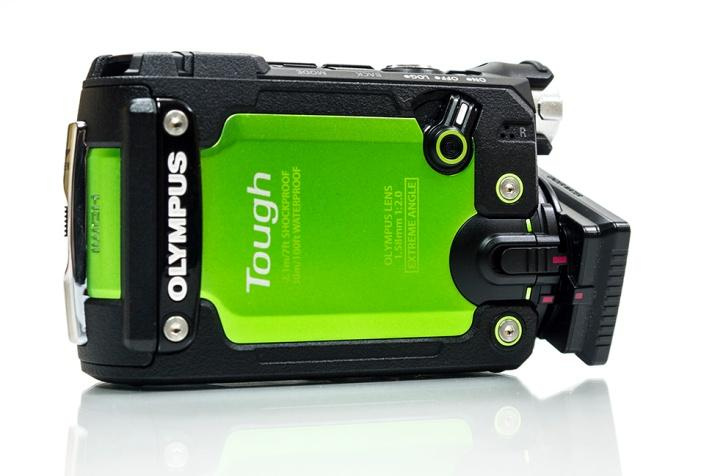
On the front side, next to the right microphone hole, there is a camera mode switch: the central position is power off, tilt to the right turns on the camera, and tilting to the left activates an economical mode for storing information from sensors into LOG files. What specifically recorded sensors, we will tell in the relevant part of the review.

The back of the camera is equipped with a small TFT-IPS display with a diagonal of 1.5 inches and a resolution of 320x240 pixels. The display is protected by a durable glass with a cut along the contour, does not glare and is clearly visible under the bright rays of the sun. It can be tilted 90 degrees for ease of framing when shooting from the hand.
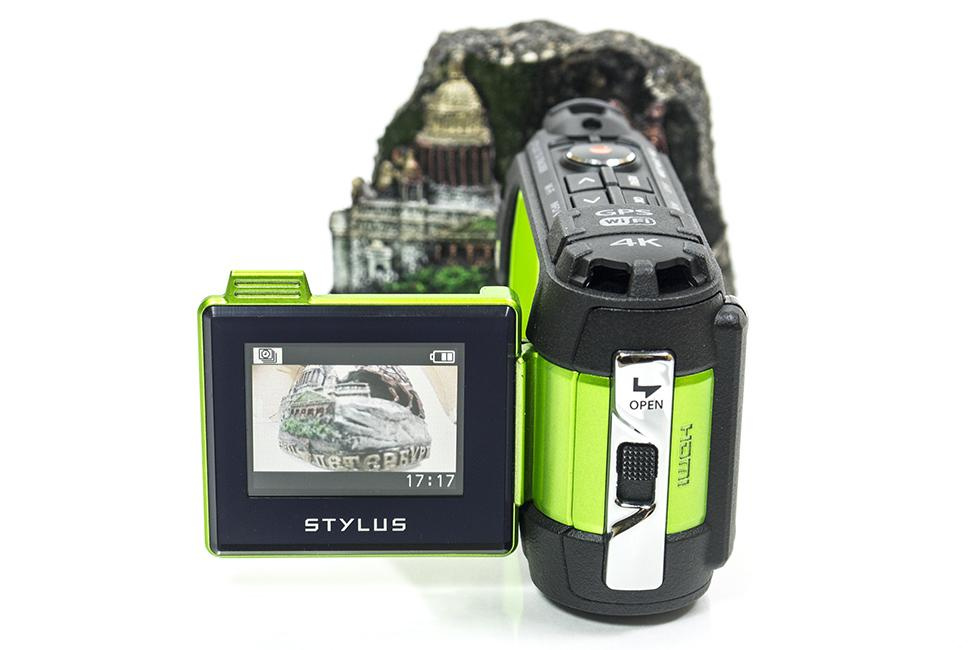
On top of the case are the main control keys. On the left is a rather large recording button and two LEDs. On the right are four control keys: menu, OK, “forward”, “backward”. Closer to the right is a massive GPS antenna unit.
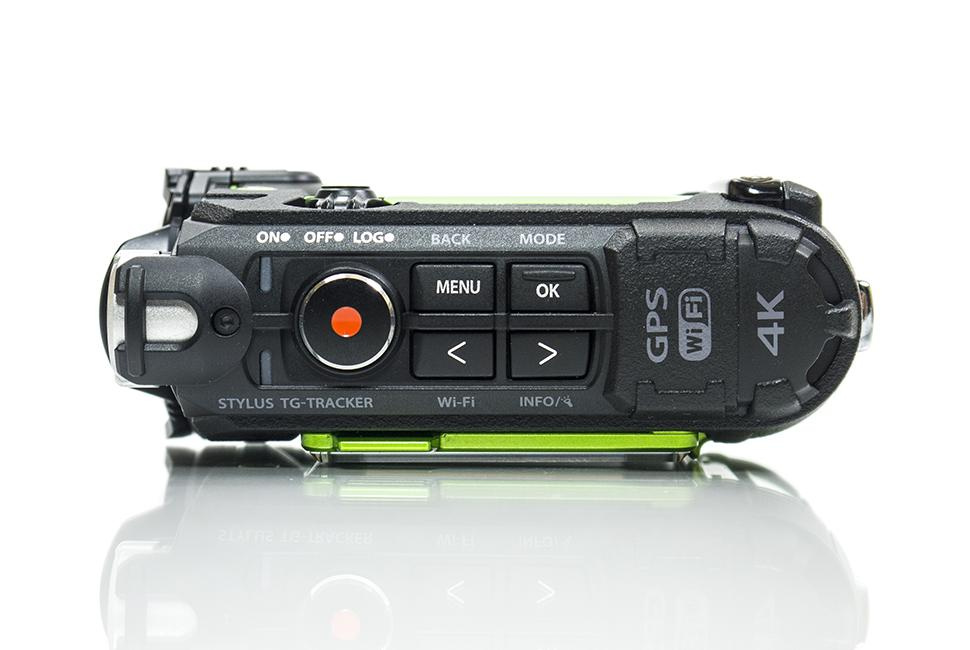
At the lower end of a medium power speaker and a steel mount for tripods and a complete transition platform.
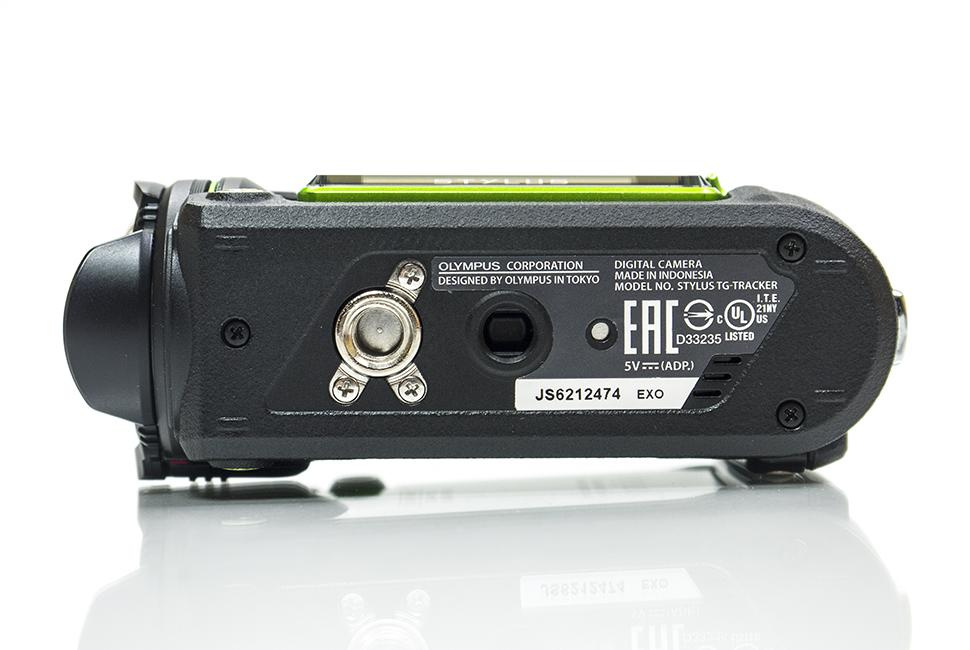
The right end draws attention with fasteners for the strap at the top and a massive lid of the interface compartment. To open it, you need to pull the lock and then pull it to the front of the case.

Behind the dense silicone gasket are micro-HDMI connectors for displaying images on an external screen and microUSB for charging and communication with a PC.
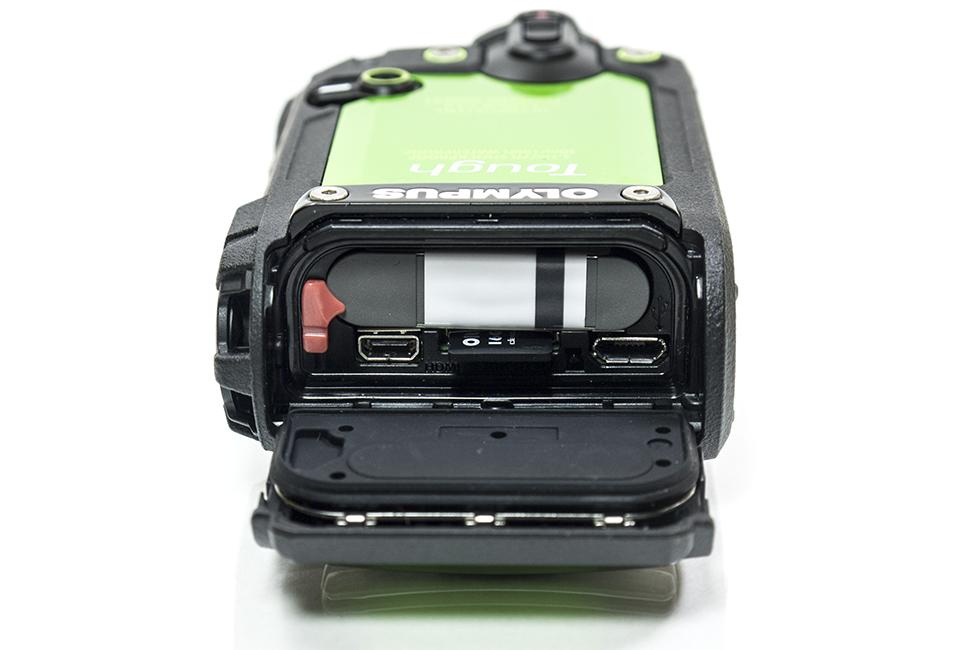
Between them there is a slot for a microSDXC memory card and a lithium-ion battery. 1350 mAh battery capacity - the same batteries are used in many other Olympus cameras.
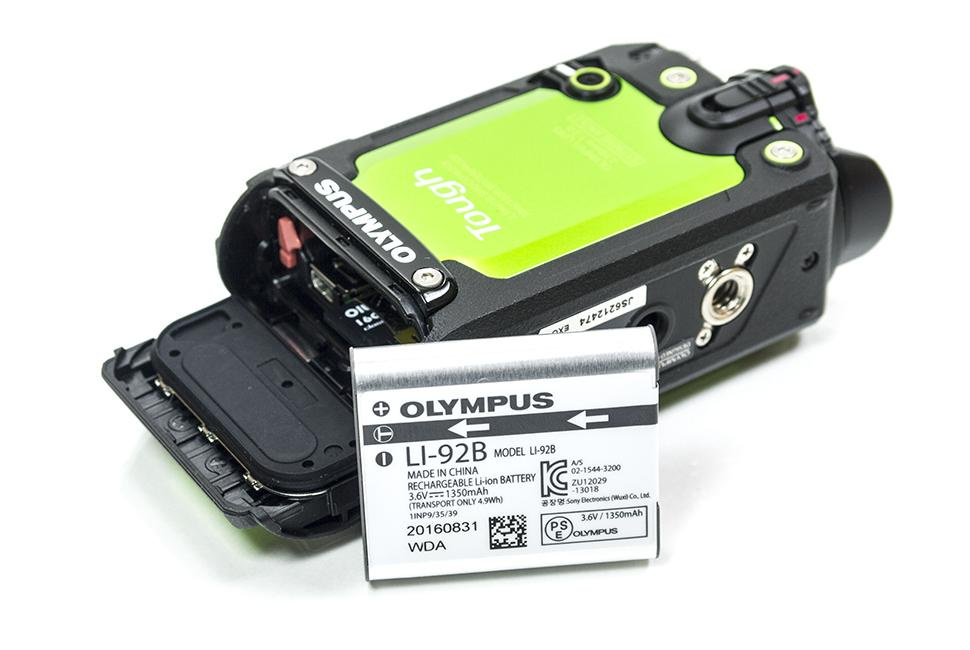
Specifications Olympus TG-Tracker
|
Matrix:
| CMOS 1 / 2.3 "7.2 MP
|
Optics:
| Viewing angle 204 °; foc. distance of 13.9 mm; aperture F: 2.0
|
Video resolution:
| 3840x2160 (30k / s), 1920x1080 (60 fps), 1280x720 (240 fps), 800x480
|
Photo resolution:
| 3840x2160, 1920x1080, 1280x720, 800x480
|
Stabilizer:
| digital
|
Wireless connection:
| GPS, Wi-Fi
|
Sensors:
| thermometer, barometer, gyroscope, accelerometer, compass
|
Nutrition:
| Li-Ion 1350 mAh
|
Dimensions:
| 93.2 x 56.5 x 32 mm
|
Price
| 23 990 rub.
|
Ergonomics and protection
The longitudinal positioning of the lens in the Olympus TG-Tracker may seem strange at first glance. But in everyday use, it is convenient as well as transverse. The camera can be safely held with one hand, although the weight of 178 grams has more to use mounting systems or a complete handle.
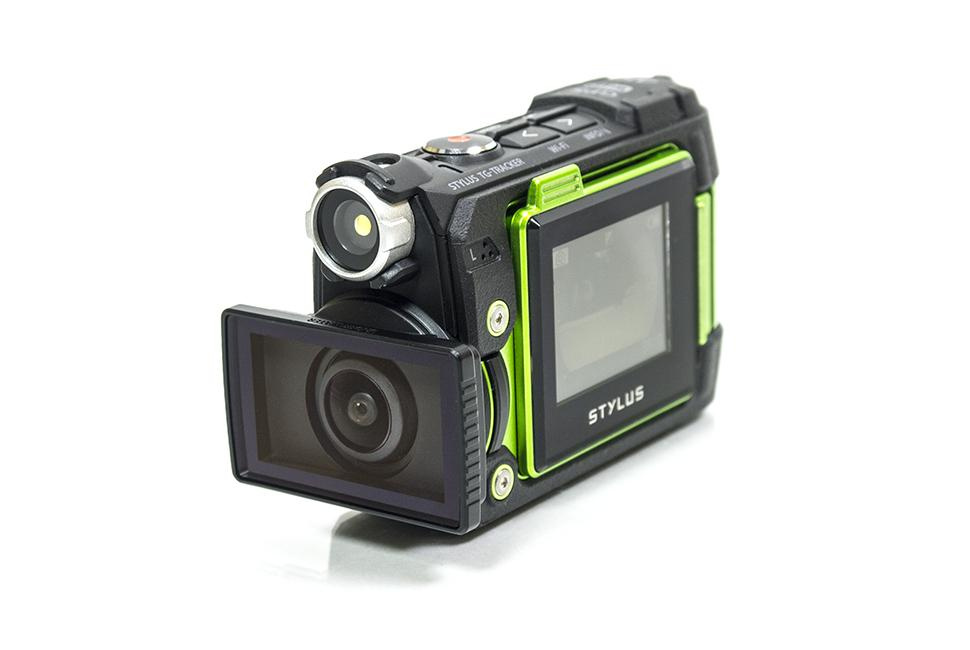
The complete handle is also made of rigid plastic with a screw assembly, equipped with an adjustable platform with a mirror for framing the self-portrait, as well as an inch mount on a tripod.
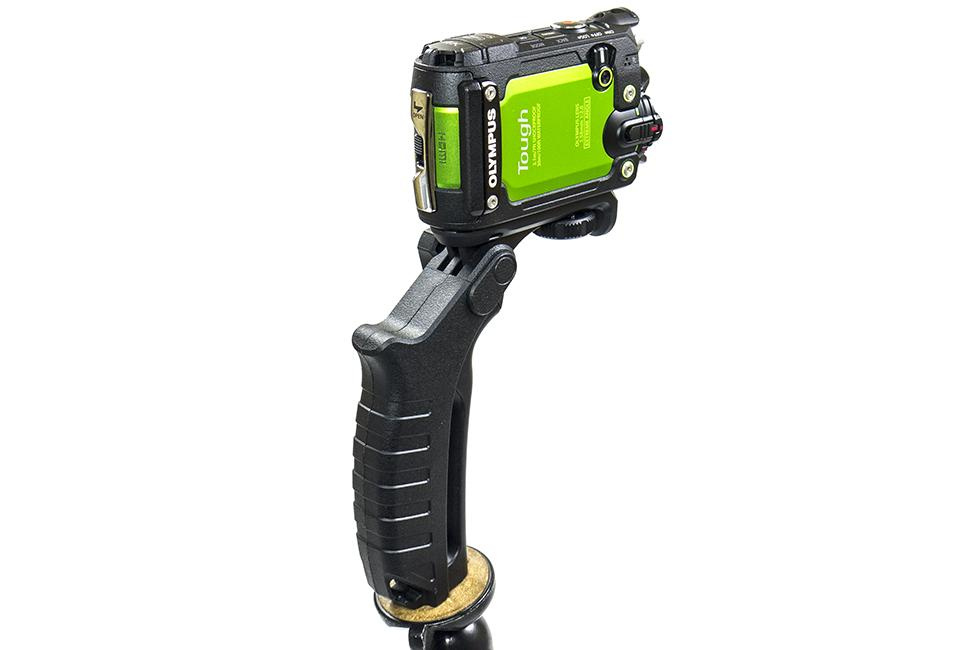
The platform can be removed and installed on popular mount systems for other sports cameras. The site has openings for the barometer and camera dynamics, and the surface that comes into contact with the camera is covered with a rubberized substrate.
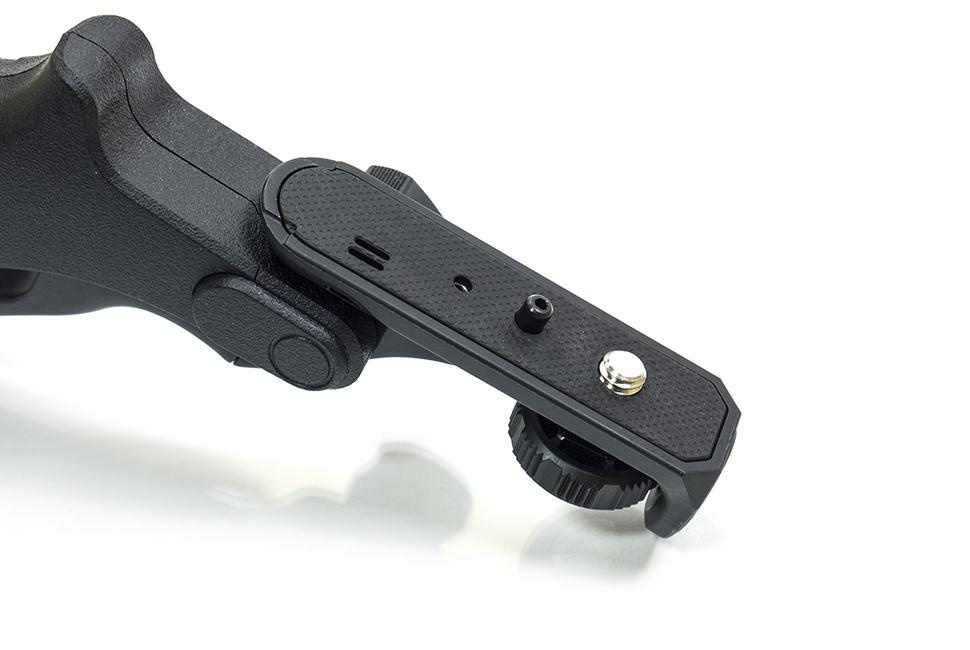
Now let's talk about camera protection. The manufacturer claims protection from shocks and falls in the framework of the standard MIL-STD 810, which allows you to safely drop the camera from a height of 2.1 meters and stand on it. Screw assembly, rough plastic and thick cut glass display - there is no reason to doubt these statements. Moisture protection here according to the standard IPX8 - allows you to sink with the camera under water to a depth of 30 meters. Outside the standards, the manufacturer claims performance at temperatures down to -10 ° C, which is especially useful in winter.
Interface
The camera turns on literally in one second, after which the viewfinder with a charge remaining indicator and set shooting modes and the remaining time at the current recording settings opens. By clicking on the OK button, you can switch to the photo and interval shooting modes, or open the gallery and settings.
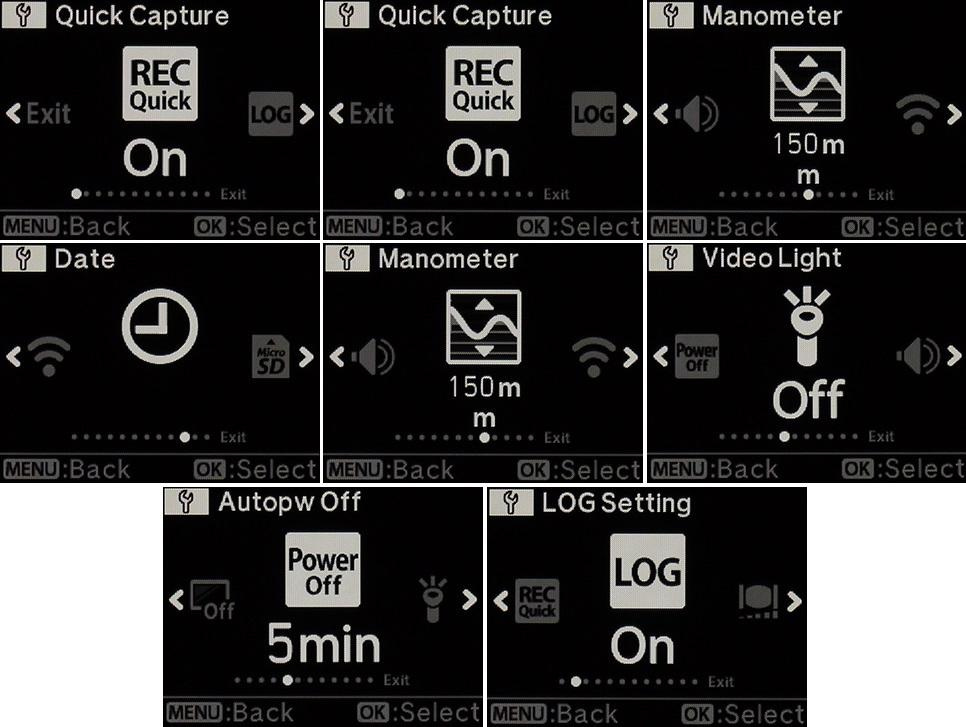
In the settings, you can set the record mode to turn on, record LOG-files, screen brightness and speaker volume, turn on the flashlight when shooting and automatic shutdown time, as well as adjust the current altitude and date.
The MENU key is responsible for setting the recording in the selected mode. For video, there is a choice of resolution and frame rate, exposure compensation, white balance presetting, viewing angle and vertical inversion, turning on the stabilizer and recording a new file when shaken (G Chapter), plus splitting rollers into 3/5/10 minutes.
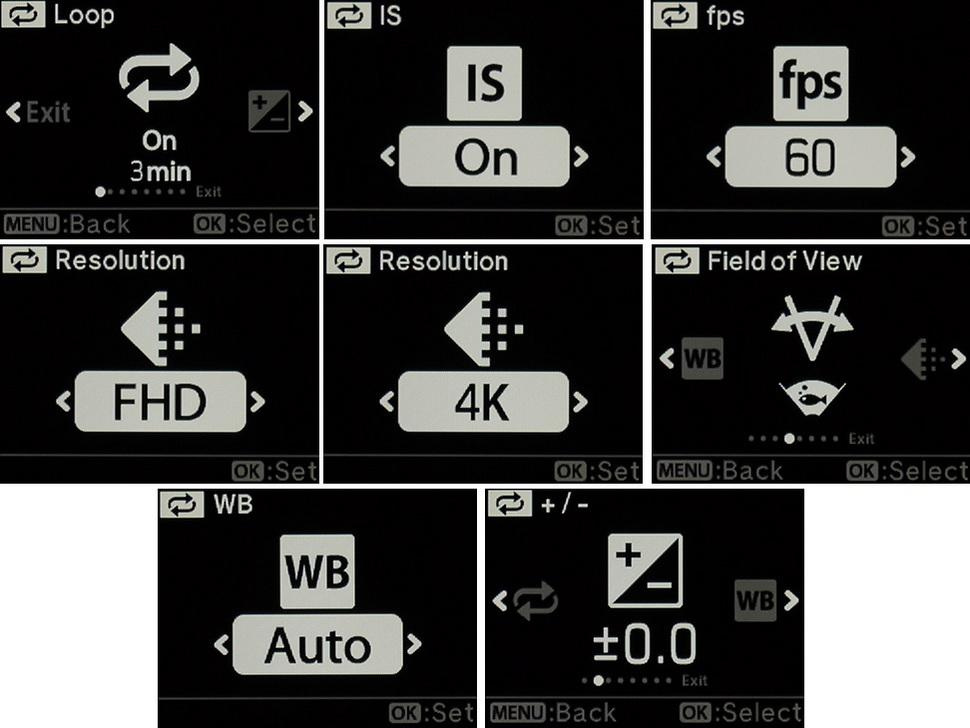
In photo mode, you can set the interval of the series from 0.5 seconds to 1 minute, choose the resolution and the same exposure compensation with white balance.
Interval video is shot in the same adjustable interval between frames, but with resolution and video formats.
The camera has a simple gallery for viewing photos and videos with the possibility of frame-by-frame viewing of clips and deleting unnecessary files.

Olympus TG-Tracker also allows you to view information from sensors in real time, switching between them using the ">" key. Here you will have both a compass for determining the direction, and a barometer with a level and an altimeter, and an odometer of the distance traveled vertically and horizontally — all of this data is recorded in LOG files that can be viewed using mobile applications.

Additional software
The Olympus TG-Tracker camera is equipped with a Wi-Fi module for communicating with smartphones and running two applications: OI.Track and OI.Share, available in the AppStore and Google Play.
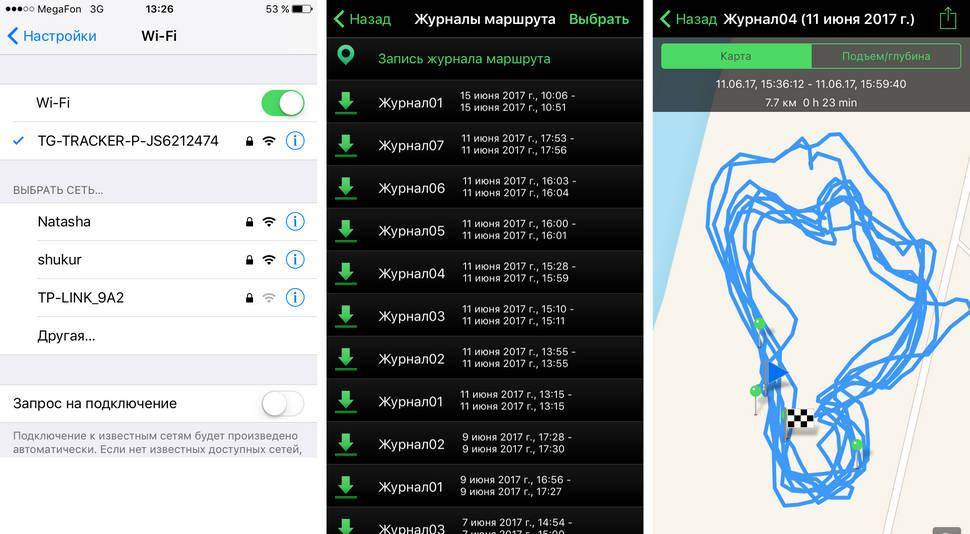
The Track application uses data from the LOG-files and allows you to explore your route on a map, view data on movements, including ups and downs, at the same time looking at the footage. If desired, you can download the selected files in the memory of your smartphone, or restrict yourself to streaming viewing in compressed quality.
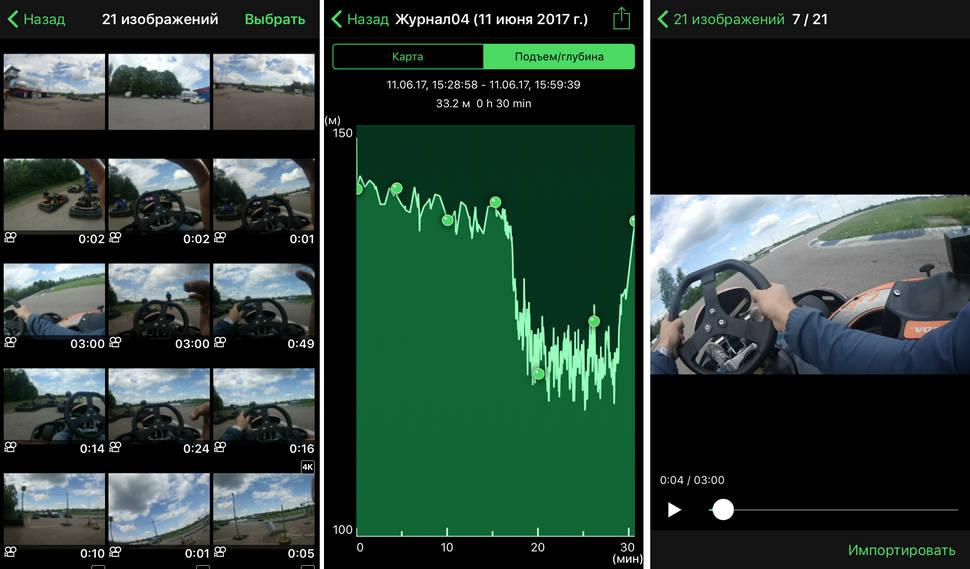
The Share application allows you to monitor the viewfinder image in Live View mode and, if necessary, edit the resulting file. This utility is better suited for managing files before publishing, but the data from the sensors no longer shows.
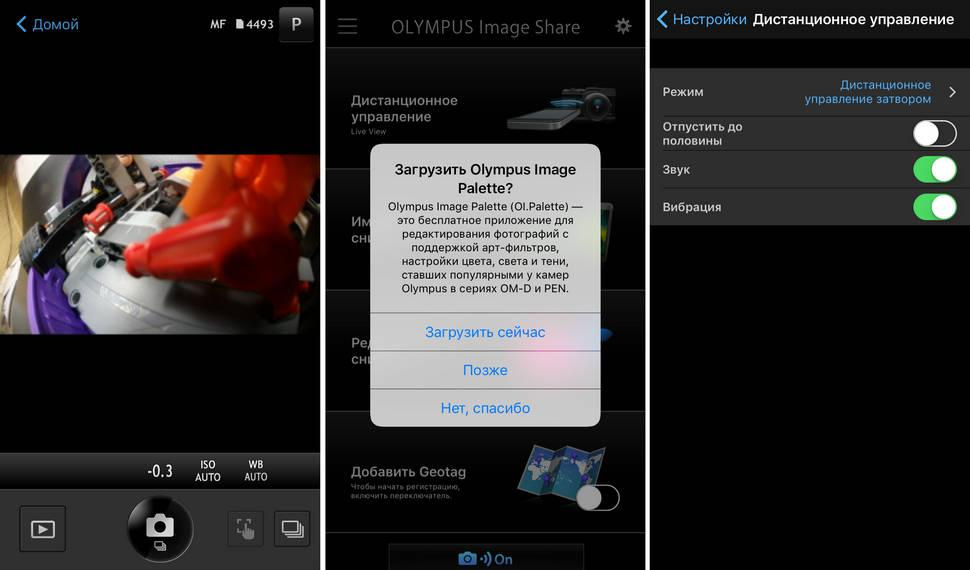
The camera is in action
The robust Olympus TG Tracker camera leaves no doubt that it will pass the test in any conditions and will probably endure the night in the cold. But what result can be obtained with its help? You can choose from recording 4K-videos with a frequency of 30 fps, Full HD up to 60 fps and HD 720 with a frequency of up to 240 frames per second. There is also a 480p resolution, but this will be needed only in case of a severe lack of memory space. We stopped at Full HD at 60 fps, so as not to sacrifice the detail and keep the maximum dynamics in the frame. Stabilization is enabled, logies are recorded, and what is the result?
Sunny day, quiet city location and an increasingly popular electric scooter - TG Tracker writes such a scene easily, adequately adjusting the exposure of shadows and sky, with overexposures minimal in class and a decent level of dynamic range.
A helmet without a camera mount is not a hindrance to remove the race, but for the stabilization system it is a serious test. Perceptible lateral overloads and regular camera shocks on the helmet could turn the video into a blurry material unsuitable for viewing, but the five-axis stabilization of the TG Tracker showed everything it could.
Nevertheless, in the video there are noticeable distortions introduced by the lens of the camera, which took 204 ° widescreen shots. Moreover, it is clear that at the software level, the camera is trying to correct these distortions, but due to constant shaking, this does not always work correctly. The manufacturer indicates that in such conditions it is better to switch the camera to a more narrow-format mode with an angle of 156 °. So the distortion will be much less. To compare the picture in these two modes, we took two static photos:
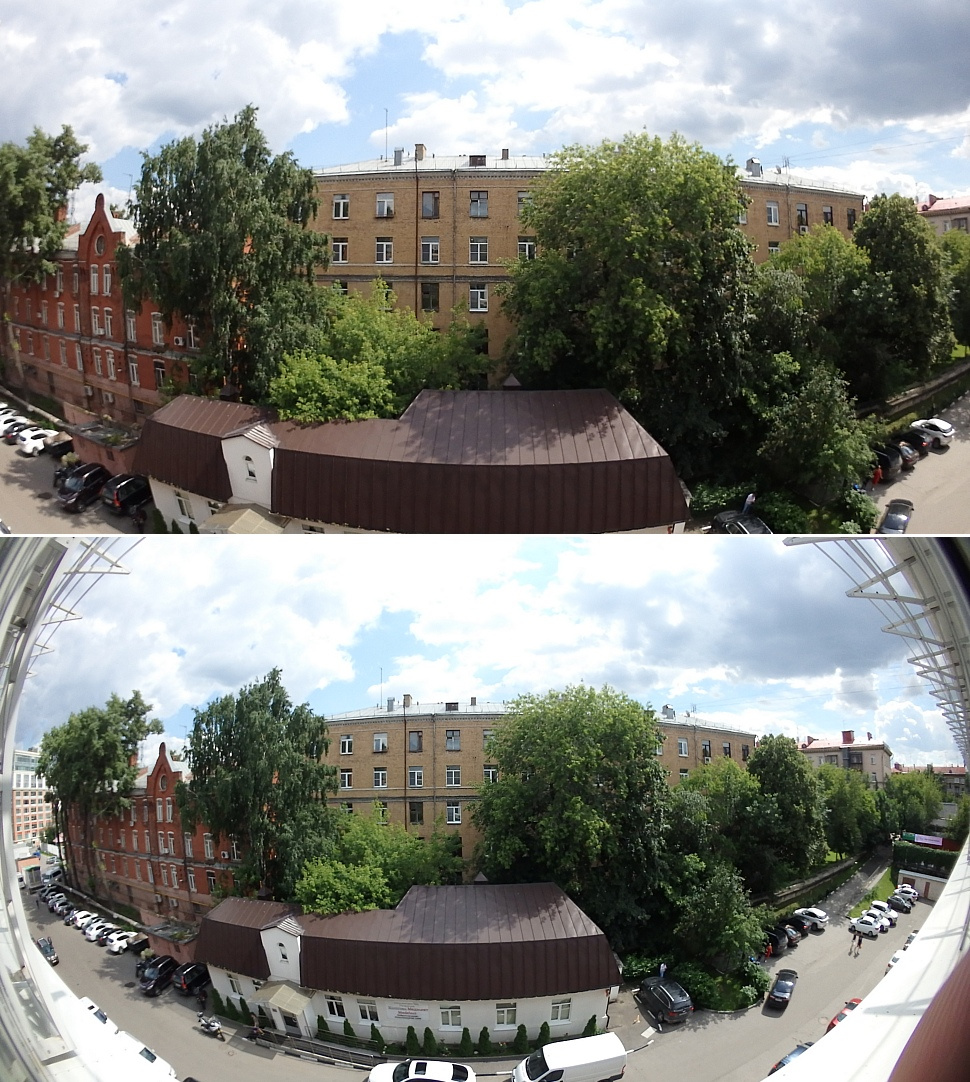
Separately, I want to praise the quality of stereo sound recording, with a decent coverage of low frequencies.
Two o'clock in the morning, light country serpentine and dim lighting - not yet Sochi, but much more interesting than a boring trip in the city. Due to the wide viewing angle and optics with a F: 2.0 aperture, the camera demonstrates adequate white balance and a good level of frame detail. The noise level is typical for this kind of camera.
As an example of shooting in Timelapse mode with a frequency of 2 fps, clouds approach at dawn, accelerated with the rising sun. This video was shot in 4K resolution, the benefit here is not so important is the dynamics of what is happening.
Camera mode is purely nominal, because the final images are no different from the frames of video clips. The resolution and frame format are also 4K, Full HD and HD Ready.
Working hours
Olympus extensive experience in creating compact cameras has achieved excellent results battery life TG Tracker. On average, when using Wi-Fi and recording videos in Full HD resolution, the camera lasts for 75 minutes, or for 1.5 hours without Wi-Fi. This time takes into account the activity of all background sensors and the collection of coordinates on GPS, so that the result can be safely called one of the best in the class.
Results
The
Olympus TG-Tracker sports camera is not inferior to competitors in terms of shooting quality and device attachment capabilities, but significantly exceeds them in terms of weaponry. The manufacturer awarded the Olympus TG-Tracker with an abundance of sensors and sensors for monitoring movements, continuous logging of LOG-files and a high level of protection against water and drops. The “brutal” TG-Tracker can be safely taken on the most extreme journey and not worry about the vagaries of electronics - this camera will stand any challenge.
